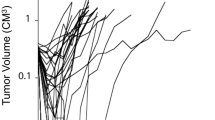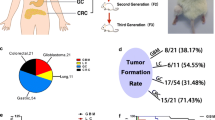Abstract
Human tumors transplanted into nude mice have long been used to assess the effectiveness of antitumor drugs and yet there is still no established standard method in preclinical practice for screening new antitumor drugs in vivo using nude mice. Thus, a cooperative study on the feasibility of a human tumor / nude mouse system for the in vivo screening of drugs was conducted by the Japanese Research Society for Chemosensitivity of Cancer. Two human stomach cancers, H-111 and SC-6-JCK, and one human colon cancer, Co-4, were transplanted serially into nude mice and used as gastrointestinal tract tumors with stable tumor growth. The appropriate dosage of six well-known antitumor drugs [mitomycin C (MMC), cyclophosphamide (CPA), nimustine hydrochloride 1-(4-amino-2-methyl-5-pyrimidinyl) methyl-3-(2-chloroethyl)-3-nitrosourea hydrochloride (ACNU), cis-platinum (II) diaminodichloride (CDDP), adriamycin (ADM) and 5-fluorouracil (5-FU)] in human tumor-bearing nude mice was determined based on the maximum tolerance dose of the drug. The respective dosages were 6 mg/kg of MMC×1 (i.p.), 120 mg/kg of CPA×1 (i.p.), 30 mg/kg of ACNU×1 (i.p.), 8 mg/kg of CDDP×1 (i.p.), 8 mg/kg of ADM×1 (i.v.), and 50 mg/kg of 5-FU q4d×3 (i.p.). Three weeks after treatment, drug effectiveness was judged by the tumor growth inhibition rate. Treatment with these appropriate doses appeared to show the maximum effect of the respective drugs on the tumor-bearing nude mice. This standardized method using nude mice should contribute to the screening of new antitumor drugs against human tumors, especially those of the gastrointestinal tract. The antitumor activity of new drugs on human tumors in vivo may now be determined by comparison with that of well-known antitumor drugs on human tumor-bearing nude mice.
Similar content being viewed by others
References
Rygaard J, Povlsen CO (1969) Heterotransplantation of human malignants to “nude” mice. Acta Pathol Microbiol Immunol [c] Scand 77:758–760
Simosato Y (1978) Nude mouse: Application for cancer study (in Japanese). Tanpakushitsu Kakusan Koso 23:719–732
Povlsen CO, Jacobsen GK (1975) Chemotherapy of a human malignant melanoma transplanted in the nude mice. Cancer Res 35:2790–2796
Ovejera AA, Houchens DP, Barker AD (1978) Chemotherapy of human tumor xenografts in genetically athymic mice. Ann Clin Lab Sci 8:50–56
Fujita M, Taguchi T (1982) Comparison between the chemotherapy of human cancer xenografts in nude mice and the clinical responses observed in the donor patients. In: DR Norman (ed) Proc 3rd int workshop on nude mice. Gustav Fisher, New York, pp 621–629
Kubota T, Shimosato Y, Nagai K (1978) Chemotherapy of carcinoma of the human stomach and colon serially transplanted in nude mice. Jpn J Cancer Res 69:299–309
Tashiro T, Fujimoto S, Kobayashi T, Inaba M (1983) Fundamental studies on the evaluation of anticancer effects using human tumor/mouse system (in Japanese). Jpn J Cancer Chemother 10:973–980
Ichihashi H, Imaizumi M, Ikoma N, Suyama M, Kondo T (1978) Comparison between a sensitivity test of carcinostatic agents by “nude” mice and other in vitro sensitivity tests (in Japanese). Saishin-Igaku 33:2306–2310
Litchfield JT, Wilcoxon F (1949) A simplified method of evaluating dose-effect experiments. J Pharmacol Exp Ther 96:99–113
Geran RI, Greenberg NH, MacDonald MM, Schumacher AM, Abbott BJ (1972) Protocols for screening chemical agents and natural products against animal tumors and other biological system. Cancer Chemother Res 3:1–103
Fogh J, Tiso J, Orfero T, Orfeo T, Sharkey FH, Daniels WP, Fogh JM (1980) Thirty-four lines of six human tumor categories established in nude mice. J Natl Cancer Inst 64:745–751
Shimosato Y, Kameya T, Nagai K, Hirohashi S, Koide T, Hayashi G, Nomura T (1976) Transplantation of human tumors in nude mice. J Natl Cancer Inst 56:1251–1260
Hanatani Y, Kubota T, Yamada Y, Tsuyuki K, Nakada M, Matsumoto S, Kumai K, Yoshino K, Ishibiki K, Abe O (1980) Experimental chemotherapy of human carcinoma serially transplanted to nude mice: An evaluation of the Battele Columbus Laboratory protocol (in Japanese). J Jpn Soc Cancer Ther 15:1114–1120
Bogden AE, Kelton DE, Cobb WR, Esber HJ (1978) A rapid screening method for testing chemotherapeutic agents against human tumor xenografts. In: Houchens DP, Ovejera AA (eds) Proc of the symposium on the use of athymic (nude) mice in cancer research. Gustav Fisher, New York, pp 231–250
Griffin TW, Bogden AE, Reich SD, Antonelli D, Hunter RE, Ward A, Yu DT, Greene HL, Costanza ME (1983) Clinical trials of subrenal capsule assay as a predictor of tumor response to chemotherapy. Cancer 52:2185–2192
Yamauchi M, Yoneda T, Imaizumi M, Ichihashi H, Kamei H, Kondo T (1986) Transplantability of human tumors into nude mice (in Japanese). J Jpn Soc Cancer Ther 21:1217–1224
Povlsen CO, Jacobsen GK, Rygaard J (1973) The mouse mutant made as a model for testing of anticancer agents. In: A Spiegel (ed) The laboratory animals in drug testing fifth ICLA symposium. Fisher, Stuttgart, pp 63–72
Houchens DP, Johnson RK, Gaston MR, Goldin A (1977) Toxicity of cancer chemotherapeutic agents in athymic (nude) mice. Cancer Treat Rep 61:103–104
Fujita F, Fujita M, Kimoto Y, Taguchi T (1985) Microvascular architecture of human gastrointestinal and breast cancer xenografts in nude mice and its relation to chemosensitivity (in Japanese). Jpn J Cancer Chemother 12:1618–1624
Author information
Authors and Affiliations
Additional information
Constituting The Japanese Research Society for Chemosensitivity of Cancer (JRSCC)
Affiliated members of JRSCC (Chairman: Tatsuhei Kondo) are: NU; Nagoya University (Second department of Surgery) RIMDOU; Research Institute for Microbial Disease, Osaka University (Department of Surgery) KU; Keio University (Department of Surgery) RINMBHU; Research Institute for Nuclear Medicine and Biology, Hiroshima University (Department of Surgery) TH; Tenri Hospital (Thoracic Surgery) RITCTU; Research Institute for Tuberculosis and Cancer, Tohoku University (Department of Clinical Chemotherapy in Medicine)
Rights and permissions
About this article
Cite this article
Imaizumi, M., Kondo, T., Taguchi, T. et al. A standardized method of using nude mice for the in vivo screening of antitumor drugs for human tumors. Surg Today 23, 412–419 (1993). https://doi.org/10.1007/BF00309499
Received:
Accepted:
Issue Date:
DOI: https://doi.org/10.1007/BF00309499




